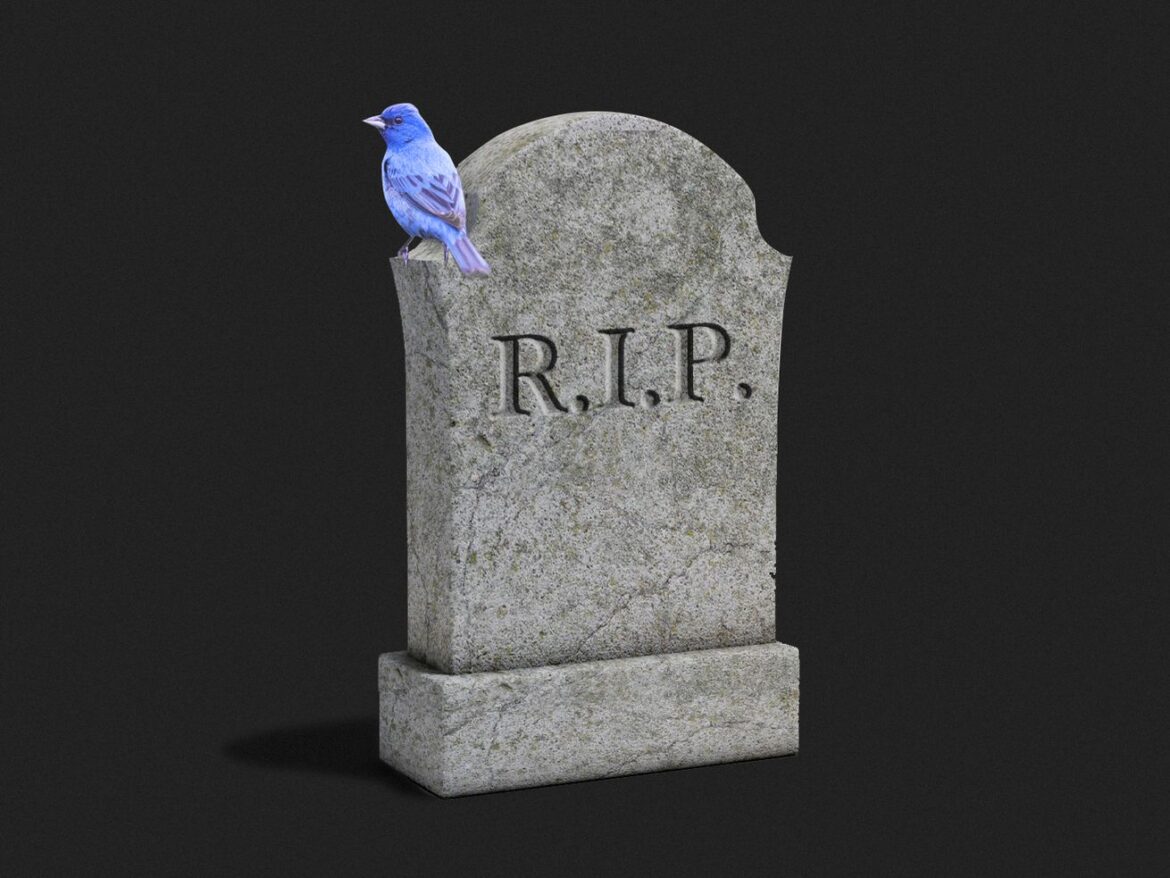After an extraordinarily chaotic past few weeks, the slow death of Twitter seems to be speeding up.
It’s been a year since Elon Musk initiated his takeover of Twitter. The six months since he actually took charge can only be characterized as chaotic, and quietly, in early April, Musk merged Twitter with a new shell company called X Corp. In other words, Twitter Inc. no longer exists.
Musk painted a rosy picture in an April 12 interview with the BBC. He said that Twitter is thriving with “record high usage” and that, despite some “compute glitches here and there,” the “site is doing really well,” advertisers who initially fled the platform after his takeover have mostly returned, and the company is on track to make a profit by next quarter. Musk also scoffed at the idea that he had destroyed Twitter, saying that predictions that the platform would “cease to exist” have “turned out to be false.”
To some extent, what Musk was saying is true: Twitter did not implode overnight in a catastrophic technical meltdown, as some of the more skeptical critics of Musk’s reign had warned.
So Twitter isn’t dead. But it’s getting there.
If you’re on Twitter today, you’re likely experiencing a feed that is more frequently broken, more random, and more unhinged. The site has seen a sustained uptick in outages and bugs. Many users are complaining about seeing more content in the new For You feed that they don’t want to see. There are active neo-Nazis on the platform. And just this week, NPR and PBS, two major news outlets with over 10 million combined followers, stopped using the platform, saying they had lost faith in Musk’s decision-making after he slapped a “government-funded media” label on the accounts.
Some people on Twitter, especially Musk’s dedicated fan base, are embracing Musk’s shake-up. But there’s no denying that Twitter today is a more unreliable experience than it was before Musk took over. Musk has justified his many controversial moves by saying that he’s doing it in the name of free speech: to remove power from check mark-touting “media elites” and distribute it to everyone else, no matter how abhorrent their views.
The problem is, Musk’s plan doesn’t seem to be working as well as he’s saying. Twitter’s web traffic dropped by nearly 8 percent last month compared to the year before, and has been dropping for the past three months year over year, according to new estimates from data intelligence firm SimilarWeb. This directly contradicts Musk’s claims that usage is up. In terms of Twitter’s main line of income, advertising, outside data also conflicts with Musk’s claims that all is well. Multiple reports over the past few months have shown that top brands are continuing to leave the platform since Musk took over.
Vox spoke with over half a dozen current and former Twitter employees, advertising and marketing experts, and users about the current state of the company. Many of those who worked at Twitter said the platform was only alive because of the technical strength and reputation it’s built over the past 17 years.
“You can blow both engines on a jet, and the jet is still going to glide,” said one former Twitter employee of seven years, who spoke on the condition of anonymity due to fear of professional repercussions. They added, however, that people should worry about Twitter’s recent privacy bugs, including one that affected Twitter Circles, a feature that’s supposed to send certain tweets only to specific users. Instead, these tweets were made public.
“If there are ways the product is breaking apart behind the scenes in ways you don’t see,” the former employee said, “then that’s a really, really bad sign.”
Any attempts to write the eulogy for Twitter, though, are still premature. Musk has a way of defying odds. And despite a batch of contenders like Substack and Artifact, there still isn’t a competing platform that’s seeing the kind of hypergrowth it would need to truly overtake Twitter. That’s partly because some of Twitter’s biggest power users, including journalists, just can’t seem to quit the platform, so it’s not clear where the new digital town square will be. Another issue is that, in the era of TikTok, the world seems to have moved on from text-based social media apps.
How exactly Twitter is losing its relevance and maybe dying is complicated. How it has managed to survive Musk’s chaotic reign, however, feels downright mysterious.
The basics: Twitter by the numbers
There are two basic questions you can ask to assess the viability of any for-profit social media platform: Are people using it? And is it making money?
On the first question, Musk says that Twitter’s usage is at an all-time high of 8 billion minutes per day. But those assertions aren’t supported by outside estimates, which — although not exact — suggest that Twitter is actually less popular than before Musk took over.
Twitter had a 7.7 percent decline in traffic in March compared to the year before, according to SimilarWeb data, which marks the third month in a row of year-over-year traffic decline. The analytics firm also recorded a 3.3 percent drop in Twitter’s unique web page visitor count year over year in March; on Twitter’s Android app, average daily active users were down 9.8 percent in March year over year.
Those numbers aren’t necessarily devastating — and Twitter was already losing users even before Musk took over — but they’re in stark contrast to the “better than ever” user numbers Musk keeps citing.
/cdn.vox-cdn.com/uploads/chorus_asset/file/24586552/GettyImages_1244262469.jpg)
Twitter account of Elon Musk/AFP via Getty Images
Part of the disparity between Musk’s numbers and those of third parties could be explained by how they’re being measured. Even if traffic is down, engagement — that is, how much people are interacting with content on Twitter — may be higher. Musk has also said he cares most about “unregretted user minutes.” This novel metric, which Musk may or may not have made up, refers to minutes that people spend on the platform that they think was time well spent.
Of course, since Twitter is no longer a public company, it doesn’t have to share the details of its user numbers on a regular basis. That means only Musk and Twitter have direct access to internal numbers on user engagement and time spent. So outside estimates of these metrics aren’t a perfect reflection of the size and growth of Twitter’s base. Nevertheless, these third-party statistics raise serious doubts about Musk’s claim that Twitter usage is at an all-time high.
On the question of whether Twitter is making money, the company has two main forms of income — advertising and subscriber revenue — neither of which seem to be doing great.
Over half of Twitter’s top advertisers from before Musk’s acquisition were still no longer advertising with the company as of last month, according to data from intelligence firm SensorTower by Pathmatics. Many of these advertisers are primarily worried about Musk’s volatile online presence, including his tweets promoting conspiracy theories. In his recent BBC interview, Musk said that advertisers are “mostly coming back,” without naming which ones.
Later this month, Musk will speak to advertisers at a major marketing conference run by advertising giant MMA, where he’ll also be interviewed by influential NBCUniversal ad exec Linda Yaccarino. This could be a chance for Musk to ease the concerns of the brands that have fled and try to convince them that business is back to normal. Privately, though, advertisers are reportedly worried about Musk’s presence at the conference, and some have raised concerns about his “racist rhetoric,” according to news outlet Semafor.
If Musk isn’t able to woo back advertisers, he’ll need subscribers for Twitter Blue, a recently revamped subscription plan that charges users for blue verification check marks and other perks, like having their tweets featured more prominently.
That’s going to be challenging. The latest metrics show that only 0.2 percent of Twitter users are paying for Twitter Blue. Twitter Blue did have an estimated 116,000 confirmed signups on the web in March, up 138 percent from the month before, according to SimilarWeb. Still, that’s not nearly enough to make up for the lost money in advertising dollars.
Musk has been working on a plan to push more people to the paid checkmarks, however. On April 20 — or 4/20, a reference to the old weed joke and possibly his favorite number — Musk says Twitter will finally revoke checkmarks from all verified users who don’t currently pay for Twitter Blue. Many notable users and newsrooms, including the New York Times, have said they don’t plan to dish out the fee of $8 a month per employee and $1,000 per month for their organizations’ checkmarks.
Convincing Twitter users to pay for something they used to get for free is a tough pitch.
“I’m skeptical that Twitter Blue will become an important source of monetization and generally believe that social media platforms can’t rely on subscriptions as their primary revenue mechanic,” Eric Seufert, an industry analyst for Mobile Dev Memo, said in a Twitter DM.
But the real sign of Twitter dying may lie beyond the pure metrics. It’s in how much more unpleasant it is for many users to spend time on the platform.
The user experience: More glitches, more Nazis, and more random content
There’s another, more subjective way to judge whether a social media app is dying or not: the quality of a user’s experience.
This is a harder metric to quantify, and there’s a mix of opinions about these kinds of changes to Twitter. However, there are some clear ways that Twitter as a product has suffered under Musk’s leadership.
For example, Twitter used to be a place for people, especially journalists, to gather for major news moments. But this month’s Trump arrest was an underwhelming moment on the platform, garnering far fewer tweets than past Trump moments on Twitter, like when the former president was diagnosed with Covid. That may be because Musk has been making the platform less journalist-friendly. But it might just be that Twitter is harder to use.
There’s been a string of notable outages that make Twitter a less reliable app, technically speaking. While Twitter has always had crashes, they’ve been more frequent lately. In February, Twitter experienced four site outages, according to the New York Times. And even when the site isn’t completely down, there are often major significant feature glitches, like earlier this week when many Twitter users were temporarily unable to reply to tweets on the web.
/cdn.vox-cdn.com/uploads/chorus_asset/file/24586557/GettyImages_1395059297.jpg)
John Shearer/Getty Images
Musk has also made some controversial changes to Twitter’s core design. A big one involved changing the site’s primary feed from a list of only users you follow to a feed that also shows more algorithmically suggested content from users you don’t follow. It’s called the For You feed, similar to TikTok’s homepage. While some people like the change, others find it harder to keep up with the users they actually follow and care about.
“Before, I would get more feeds from people and topics that I tend to visit more often,” Nalan Yurtsever, a resident pathologist at Northwell Health who mainly uses Twitter to keep up with academics in her field, said in a DM. “I feel like it has gotten worse. I spend less time on it now because it is less relevant.”
Other users complain that it’s harder to separate fact from fiction because, thanks to the changes to Twitter Blue, anyone can now buy verification and a blue check mark.
Another major concern about users’ day-to-day experience is hate speech.
In November, Musk started granting “general amnesty” to thousands of accounts that were previously banned for hate speech, violence, or misinformation. Unsurprisingly, several outside reports show that hate speech has been on the rise. Slurs against Black Americans increased from an average of 1,282 times to 3,876 times a day since Musk took over, according to a report from the Center for Countering Digital Hate published in December. And antisemitic tweets doubled from June 2022 to February 2023, according to research from the Institute of Strategic Dialogue.
Musk has insisted, including in his recent BBC interview, that those reports are false and that hate speech is declining at Twitter. Nevertheless, Twitter approved and verified a user with the n-word in his username this week. That was after the company allowed several well-known, self-avowed neo-Nazis back on the platform.
It’s still hard to say exactly how much this hate speech gets seen. It’s possible that, as Musk has previously claimed the platform would do, Twitter has down-ranked people who produce hate speech so that even if there are more instances of hate speech, those tweets are viewed less often.
Overall, there are certainly users who like the changes Musk has made to Twitter’s feed and content moderation policies. Many of them tend to fit into one of a handful of categories: Musk’s dedicated fans, people who were previously suspended from Twitter, and people with interests that align with Musk’s follower base, like crypto and Tesla.
So one could argue that, over time, we won’t see Twitter die completely but rather shrink to fit a user base that’s more niche.
Why Twitter may be dying but isn’t dead yet
Despite all of Twitter’s problems, it’s still kicking — and there are a few major reasons for that.
For one, Musk has successfully drawn attention to Twitter by creating drama around his own actions. Each week seems to bring a new publicity stunt, like when Musk changed the logo on Twitter’s app and website to a doge icon or when he altered the sign outside Twitter headquarters to read “Titter.” Musk’s recent spur-of-the-moment interview with the BBC drew in more than 3 million listeners on Twitter Spaces; for comparison, about 2 million people watch Fox News during primetime.
In other words, Musk is a master troll.
And while Musk’s antics alienate many users, some conservatives have celebrated his leadership at Twitter, seeing him as someone who liberated the company from what they saw as overly strict content moderation policies. In fact, in the days after Musk’s takeover, conservative accounts saw their follower counts go up.
There are also a few signs of hope for Twitter on the advertising front. Despite the broader brand exodus, a handful of major companies, including McDonald’s, Disney, and Apple, continue to spend on the platform.
/cdn.vox-cdn.com/uploads/chorus_asset/file/24586554/GettyImages_1251763316.jpg)
Tayfun Coskun/Anadolu Agency via Getty Images
But by far, the main reason Twitter is still alive is because there is no viable competitor.
The decentralized network Mastodon, for one, has attracted many journalists. But unlike Twitter, it runs on a collection of disparate, interconnected servers, which makes it difficult for the average user to navigate. The popular newsletter platform Substack has recently emerged as another Twitter competitor — Musk also recently banned the company on Twitter — but it’s not clear how much time Substack users will want to spend on a feed when they’re used to reading writers they follow in their inbox. Then there’s Artifact, a startup created by Instagram co-founder Kevin Systrom that’s still in its early stages. Even Meta is reportedly working on a text-based social network, though we still don’t have many details about how it would work.
“Twitter is unique. News breaks on Twitter. Culture happens on Twitter,” said advertising executive Lou Paskalis, chief strategy officer of Ad Fontes Media, who has tried other alternatives like Post News. Paskalis says he’s still clinging to Twitter despite the recent changes to the platform and Musk’s “carelessness with the things most important to advertisers and beloved by heavy users of the platform.”
If we want to understand the future of Twitter, we can look to what we know about its new parent company: X. The move was unannounced and unexplained, but it’s related to Musk’s long-stated plans of turning Twitter into an “everything” app, similar to WeChat in China, that will be used to do things like make payments, order food, and hail rides.
Wharton marketing professor Patti Williams, who studies people’s opinions about companies, thinks the move may have something to do with Musk appealing to his base. Musk has “shaken” Twitter’s reputation, she said, and is disrupting the trust it had with journalists and their audiences. But that’s just one type of audience. For all of the news junkies, culture makers, and politicos he alienates, Musk might be gaining more diehard users, including Tesla enthusiasts, coders, crypto traders, and gamers.
In essence, Musk is jeopardizing the strength of Twitter’s brand, but he’s also building a new one in the process.
“There’s a lot of value in the Twitter name,” said Williams. “But only if Twitter aspires to what it has been.”
So, is Twitter dying? The answer is, the old Twitter is already dead. We’re all living in Musk’s more chaotic, drama-filled, polarizing Twittersphere now.
What’s uncertain is what the new Twitter — or X or whatever Musk calls it — will ultimately look like. And whether it will survive.



